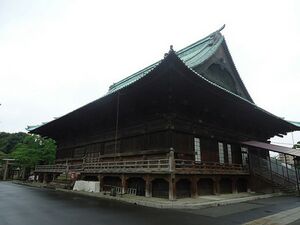Difference between revisions of "Gokoku-ji (Tokyo)"
| Line 14: | Line 14: | ||
{{stub}} | {{stub}} | ||
| + | |||
| + | ==Famous Burials== | ||
| + | *[[Josiah Conder]] | ||
| + | *[[Dan Takuma]]<!--團琢磨--> | ||
| + | *[[Futara Yoshiyuki]]<!--二荒芳之--> | ||
| + | *[[Hattori Unokichi]]<!--服部宇之吉--> | ||
| + | *[[Hirata Tosuke|Hirata Tôsuke]]<!--平田東助--> | ||
| + | *[[Ikeda Shigeaki]]<!--池田成彬--> | ||
| + | *[[Kiyooka Tomoharu]]<!--清岡公張--> | ||
| + | *[[Komasu Teruhisa]]<!--小松輝久--> | ||
| + | *[[Kuni Kunihisa]]<!--久邇邦久--> | ||
| + | *[[Masuda Takashi]]<!--益田孝--> | ||
| + | *[[Matsudaira Fumai]] | ||
| + | *[[Muto Nobuyoshi|Mutô Nobuyoshi]]<!--武藤信義--> | ||
| + | *[[Nanbu Toshinaga]]<!--南部利祥--> | ||
| + | *[[Noma Seiji]]<!--野間清治--> | ||
| + | *[[Okuma Shigenobu|Ôkuma Shigenobu]] | ||
| + | *[[Sanjo Sanetomi|Sanjô Sanetomi]] | ||
| + | *[[Shimazu Tadatsugu]]<!--島津忠承--> | ||
| + | *[[Shimoda Utako]]<!--下田歌子--> | ||
| + | *[[Takahashi Soan|Takahashi Sôan]]<!--高橋箒庵--> | ||
| + | *[[Takezoe Shinichiro|Takezoe Shin'ichirô]]<!--竹添進一郎--> | ||
| + | *[[Tanaka Mitsuaki]]<!--田中光顕--> | ||
| + | *[[Torio Atsutaka]]<!--鳥尾敬孝--> | ||
| + | *[[Ume Kenjiro|Ume Kenjirô]]<!--梅謙次郎--> | ||
| + | *[[Yamada Akiyoshi]]<!--山田顕義--> | ||
| + | *[[Yamagata Aritomo]] | ||
| + | *[[Yasuda Zenjiro|Yasuda Zenjirô]]<!--安田善次郎--> | ||
==References== | ==References== | ||
*Anne Walthall, "Hiding the shoguns: Secrecy and the nature of political authority in Tokugawa Japan," in Bernard Scheid and Mark Teeuwen (eds.) ''The Culture of Secrecy in Japanese Religion'', Routledge (2006), 347-348. | *Anne Walthall, "Hiding the shoguns: Secrecy and the nature of political authority in Tokugawa Japan," in Bernard Scheid and Mark Teeuwen (eds.) ''The Culture of Secrecy in Japanese Religion'', Routledge (2006), 347-348. | ||
| + | *Pamphlets available on-site. | ||
==External Links== | ==External Links== | ||
Revision as of 03:37, 11 November 2014
- Established: 1682
- Japanese: 護国寺 (gokoku-ji)
The Gokoku-ji (lit. "Protection of the Nation Temple") in Tokyo was founded in 1682 as a private temple for Keishôin, the mother of Shogun Tokugawa Tsunayoshi.
The temple contains a Tôshôgû, a Shinto shrine dedicated to the spirit of Tokugawa Ieyasu, erected within the grounds in 1691. Six years later, the main hall of the temple was rebuilt, and the temple was reestablished as a public temple, no longer a private space.
The temple is dedicated to Daigensui Myôô, a deity associated with the protection of the realm, and in particular the defeat or destruction of enemies of the state. Daigensui is also enshrined in at least one temple in Yamashiro province, serving as protector of the Imperial capital of Kyoto; here, in Edo, he was chosen as a guardian deity to protect the Tokugawa shogunate.
Another prominent object of worship at the temple is an image of the 33-bodied Buddha (sanjûsanjin), commissioned in 1704 by Keishôin upon her 77th birthday; each of the thirty-three statues contains a strand of Keishôin's hair, and one is believed to have been sculpted to represent Keishôin herself, as a spirit, deity, or Buddha helping to protect the shogun and his realm.
Adjacent to the Gokoku-ji is the Toshima-ga-oka Cemetery, which contains exclusively Imperial graves.
Famous Burials
- Josiah Conder
- Dan Takuma
- Futara Yoshiyuki
- Hattori Unokichi
- Hirata Tôsuke
- Ikeda Shigeaki
- Kiyooka Tomoharu
- Komasu Teruhisa
- Kuni Kunihisa
- Masuda Takashi
- Matsudaira Fumai
- Mutô Nobuyoshi
- Nanbu Toshinaga
- Noma Seiji
- Ôkuma Shigenobu
- Sanjô Sanetomi
- Shimazu Tadatsugu
- Shimoda Utako
- Takahashi Sôan
- Takezoe Shin'ichirô
- Tanaka Mitsuaki
- Torio Atsutaka
- Ume Kenjirô
- Yamada Akiyoshi
- Yamagata Aritomo
- Yasuda Zenjirô
References
- Anne Walthall, "Hiding the shoguns: Secrecy and the nature of political authority in Tokugawa Japan," in Bernard Scheid and Mark Teeuwen (eds.) The Culture of Secrecy in Japanese Religion, Routledge (2006), 347-348.
- Pamphlets available on-site.
